of Xenopedia's Improvement Drive.
- "Whoever wins... we lose."
- ―Alien vs. Predator tagline
Alien vs. Predator, also known as AVP: Alien vs. Predator and often shortened to AVP, is a 2004 science fiction film directed by Paul W. S. Anderson and starring Sanaa Lathan, Raoul Bova, Lance Henriksen, Ewen Bremner, Colin Salmon, Tommy Flanagan, Carsten Norgaard, Tom Woodruff, Jr. and Ian Whyte. It is based on the crossover Alien vs. Predator franchise, a concept which originated in a 1989 comic book, although the film features an original story written by Anderson, Dan O'Bannon and Ronald Shusett. The screenplay, by Anderson and Shane Salerno, was influenced by Aztec mythology, the comic book series, and the writings of Erich von Däniken.
Set in 2004, Alien vs. Predator follows a group of paleontologists, archaeologists and others assembled by billionaire Charles Bishop Weyland for an expedition to a remote island off Antarctica, after a mysterious heat signal is discovered under the ice. Weyland and the group discover a pyramid buried beneath the ice cap and hope to claim the important find for themselves. However, the structure is revealed to be an ancient hunting ground where Predators stalk and kill Aliens as a rite of passage, and the humans become caught in the middle of a battle between the two species.
Released on August 13, 2004 in North America, Alien vs. Predator received mixed to negative reviews from film critics, scoring a 22% approval rating on Rotten Tomatoes, and 29 on Metacritic. Some critics praised the special effects and set designs, while others dismissed the film for its "wooden dialogue", and "cardboard characters". Despite its poor reviews, Alien vs. Predator was more commercially successful than any of the preceding films in the Alien and Predator franchises, grossing a total of $171 million. The film's financial success led to a sequel, titled Aliens vs. Predator: Requiem (2007). The film, along with its sequel, has been widely condemned by many fans of the franchise. The Alien franchise has no information involving the events of the film so it's unknown whether it and it's sequel are canon.
Plot[]

Alexa Woods.
In 2004, a satellite detects a mysterious heat bloom beneath Bouvetøya, an island about one thousand miles north of Antarctica. In response, billionaire industrialist Charles Bishop Weyland assembles a team of scientists to investigate the heat source and claim any related discoveries for his multinational communications company Weyland Industries. The expedition includes paleontologists, archaeologists, linguistic experts, drillers and a female guide named Alexa "Lex" Woods, with security provided by Max Stafford and his team of mercenaries.
As the team travels to Bouvetøya, a Predator ship enters Earth's orbit and fires an energy beam towards the source of the heat bloom. When the Weyland Industries expedition arrives at the site above the heat source, an abandoned whaling station, they find a hole bored deep into the ice by the energy beam, and they descend to investigate. On the bedrock deep below, they discover a mysterious pyramid and begin to explore it, finding evidence of a civilization pre-dating written history and what appears to be a sacrificial chamber filled with human skeletons with ruptured rib cages. As they explore, they unwittingly activate the power source for the structure, awakening an imprisoned Alien Queen frozen deep within the pyramid.
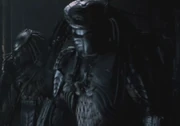
The Young Bloods stalking the humans.
Meanwhile, three Young Blood Predators land on the surface and kill the humans there, before making their way down to the pyramid. Oblivious to these events, the rest of the Weyland Industries team push on with their exploration, eventually discovering the Predators' Plasmacasters in a sarcophagus inside the pyramid. Recognizing them as incredibly advanced, possibly alien technology, they take them for study, but in doing so they activate a mechanism that causes the pyramid to rearrange its interior every ten minutes. Meanwhile, several Eggs laid by the Queen are automatically delivered to the sacrificial chamber, and several members of the human expedition still exploring there are impregnated by Facehuggers. The Chestbursters that emerge from them quickly grow into adult Aliens.
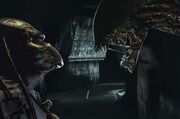
A Yautja and a Xenomorph, face to face.
The group is soon ambushed by the Predators for retrieve their weapons and most of the humans are killed, including Max and his mercenaries, while several others are taken by the Aliens to be hosts for more of the creatures. The alpha Alien, known as Grid, ambushes and kills the first Predator, Chopper. The lead Predator, Celtic, then engages Grid in a brutal fight. At first, Celtic appears to have the upper hand, but he grows over-confident and is eventually killed by Grid. Scar, now the last remaining Predator, pursues the human survivors with the aim of recovering the Plasmacasters they have stolen. Weyland dies making a stand against Scar but the two remaining survivors, Lex and an archaeologist named Sebastian, are separated from the Predator by the pyramid's shifting walls. As he waits for a chance to pursue, an Alien and a lone Facehugger sneak up on Scar and attempt to subdue him. Scar swiftly dispatches both with his Shuriken, then ritualistically marks himself by burning a glyph into his forehead using their acidic blood. Before he can put his mask back on, a second Facehugger sneaks up on Scar and lunges at him.
Through translation of the pyramid's hieroglyphics, Sebastian and Lex learn that the Predators have in fact been visiting Earth for thousands of years. It was they who taught early human civilizations how to build pyramids, and were in turn worshipped as gods. Every 100 years the Predators would return to Earth so that they could hunt Aliens, the "ultimate prey", bred from sacrificial human hosts. If the Predators became overwhelmed, they would activate their Self-Destruct Device to eliminate the Aliens and themselves, thereby explaining the mysterious and sudden disappearance of several ancient cultures. Sebastian and Lex deduce that this is why the current Predators have come to the pyramid, and that the purpose of the heat bloom was a trap to attract humans to play host for the Aliens. They decide that the Predators must be allowed to succeed in their Hunt, so that the Aliens will be prevented from reaching the surface. However, Sebastian is taken by the Aliens, leaving Lex alone.
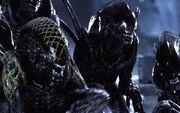
The Aliens surround Lex and Scar.
Scar, having apparently survived the earlier Facehugger ambush, eventually finds Lex and reclaims his Plasmacaster, but rather than killing her the two form something of an uneasy alliance after Lex impresses the Predator by killing an Alien. They make their way into the Alien Hive and deploy Scar's Self-Destruct Device to destroy the remaining Aliens and their eggs, successfully escaping the pyramid and reaching the surface moments before the explosion obliterates the structure. In recognition of Lex's achievements, Scar burns a glyph similar to his own into her cheek. However, they are then attacked by the Alien Queen, which has likewise escaped the pyramid. After a fierce battle, Lex and Scar defeat the Queen by chaining her to an oil vat and tipping it into the Antarctic Ocean, where it drags the Queen into the depths. Afterwards, Scar succumbs to wounds suffered during the confrontation.
Lex is shocked when a Predator ship decloaks and several Predators appear from within. They solemnly collect their fallen comrade and the Clan Leader, seeing the mark on her cheek, presents Lex with a Combistick in recognition of her skill as a warrior. The Predators depart peacefully, leaving Lex to her fate, but as they fly off into space a Predalien Chestburster erupts from Scar's corpse.
Cast[]
- Alexa Woods .... Sanaa Lathan
- Sebastian De Rosa .... Raoul Bova
- Charles Bishop Weyland .... Lance Henriksen
- Graeme Miller .... Ewen Bremner
- Maxwell Stafford .... Colin Salmon
- Mark Verheiden .... Tommy Flanagan
- Joe Connors .... Joseph Rye
- Adele Rousseau .... Agathe de La Boulaye
- Rusten Quinn .... Carsten Norgaard
- Thomas Parks .... Sam Troughton
- Stone .... Petr Jákl
- Bass .... Pavel Bezdek
- Klaus .... Kieran Bew
- Mikkel .... Carsten Voigt
- Boris .... Jan Filipenský
- Sven .... Adrian Bouchet
- Juan Ramirez .... Andy Lucas
- Supervisor .... Liz May Brice
- Technician .... Glenn Conroy
- Karl .... Eoin McCarthy
- Sacrificial Maiden .... Karima Adebibe
- Grid .... Tom Woodruff, Jr.
- Scar .... Ian Whyte
Writing[]
- See also: The Hunt: Alien vs. Predator
The concept of Alien vs. Predator originated with an Aliens vs. Predator comic book crossover published by Dark Horse Comics in the anthology issue Dark Horse Presents #36 in February 1990. This short story was quickly expanded into a four-issue series several months later. Later the same year, the idea of Aliens and Predators fighting each other was first hinted at on-screen in Predator 2, when a Xenomorph skull appeared in a trophy cabinet aboard a Predator ship.[2] Based on the success of the comic book series, in 1991 20th Century Fox commissioned Peter Briggs to write a screenplay for a movie adaptation.[2] Roland Emmerich was at one point attached to direct the film, tentatively titled The Hunt: Alien vs. Predator,[3] although the film ultimately fell through. However, in 2002 the studio returned to the concept of an Alien vs. Predator film. As there were a total of six producers between the two film franchises, producer John Davis had difficulty securing the necessary rights, as the respective groups were concerned about a film featuring the two creatures together.
Nonetheless, a new script was penned by James DeMonaco and Kevin Fox, who hoped to give the film an original approach by setting it on Earth.[4] Their draft involved a team of human researchers discovering a crashed Predator ship and using the Eggs found on board to breed Xenomorphs, hoping that the creatures' presence will lure more Predators to Earth and enable them to capture the hunters' technology.[5] However, the script was rejected by producer Davis. Paul W. S. Anderson subsequently pitched Davis a story he had been working on for eight years, and showed him related concept art created by Randy Bowen.[6] Impressed with Anderson's idea, Davis thought the story was like Jaws in that it "just drew you in, it drew you in".[7] Anderson started to work on the film after completing the script for Resident Evil: Apocalypse, with Shane Salerno co-writing. Salerno spent six months writing the shooting script, finished its development, and stayed on for revisions throughout the film's production.[8]
Influenced by the work of Erich von Däniken, Anderson researched Däniken's theories on how he believed early civilizations were able to construct massive pyramids with the help of aliens, an idea drawn from Aztec mythology;[9] Däniken's work would also provide inspiration for Ridley Scott's Prometheus.[10] Anderson wove these ideas into Alien vs. Predator, describing a scenario in which Predators taught ancient humans to build pyramids, in turn using Earth for rite of passage rituals every 100 years in which adolescent Predators would hunt Xenomorphs, bred from sacrificial members of those ancient civilizations. To explain how these ancient peoples "disappeared without a trace", Anderson came up with the idea that the Predators, if overwhelmed by the Xenomorphs, would use their Self-Destruct Devices to contain the situation, wiping out the Xenomorphs at the expense of the civilization that surrounded them.[9] H. P. Lovecraft's 1931 novella At the Mountains of Madness also served as an inspiration for the film, and several elements of the Alien vs. Predator comic series were included as well.[11][6] Anderson's initial script called for five Predators to appear in the film, although the number was later reduced to three.[9]
As Alien vs. Predator is both a sequel to the Predator films and a prequel to the Alien series, Anderson was cautious of contradicting continuity in the franchises. He chose to set the film on the remote Norwegian Antarctic island of Bouvet, commenting, "It's definitely the most hostile environment on Earth and probably the closest to an Alien surface you can get."[12] Anderson thought that setting the film in an urban environment like New York City would break continuity with the Alien series as the protagonist, Ellen Ripley, had no knowledge the creatures existed. "You can't have an Alien running around the city now, because it would've been written up and everyone will know about it. So there's nothing in this movie that contradicts anything that already exists."[12]
Dan O'Bannon later claimed that unused elements from his original spec screenplay for Alien were used in the film, including the pyramid and even the unused cocoon sequence from the film. This situation led to him and Ronald Shusett receiving a story credit.[13]
Casting[]

Lance Henriksen was the first to be cast in Alien vs. Predator as Anderson wanted to keep continuity with the Alien series.
The first actor to be cast for Alien vs. Predator was Lance Henriksen, who played the characters Bishop in Aliens and Michael Bishop in Alien3. Although the Alien movies are set 150 years in the future, Anderson wanted to keep continuity with the series by including a familiar actor. Henriksen plays billionaire Charles Bishop Weyland, a character that ties in with the Weyland-Yutani Corporation of the Alien films. According to Anderson, Weyland becomes known for the discovery of the pyramid, and as a result the Weyland-Yutani Corporation models the Bishop android in the Alien films after him; "when the Bishop android is created in 150 years time, it's created with the face of the creator. It's kind of like Microsoft building an android in 100 years time that has the face of Bill Gates."[14]
Anderson opted for a European cast including Italian actor Raoul Bova, Ewen Bremner from Scotland, and English actor Colin Salmon. Producer Davis said, "There's a truly international flavor to the cast, and gives the film a lot of character."[15] Several hundred actresses attended the auditions to be cast as the film's heroine Lex Woods. Sanaa Lathan was selected, and one week later she flew to Prague to begin filming. The filmmakers knew there would be comparisons to Alien heroine Ellen Ripley and did not want a clone of the character, but wanted to make her similar while adding something different.[15]
Anderson reported in an interview that California Governor Arnold Schwarzenegger was willing to reprise his role as Major Alan "Dutch" Schaefer from Predator in a short cameo appearance, on the conditions that he lose the recall election and that the filming take place at his residence.[16] Schwarzenegger, however, won the election with 48.58% of the votes and was unavailable to participate in filming. Actress Sigourney Weaver, who starred as Ripley in the Alien series, said she was happy not to be in the film, as a possible crossover was "the reason I wanted my character to die in the first place", and thought the concept "sounded awful".[17][18]
Set Design and Filming[]

The first look at the underground pyramid.
Production began in late 2003 at Barrandov Studios in Prague, Czech Republic, where most of the filming took place. Production designer Richard Bridgland was in charge of sets, props and vehicles, based on early concept art Anderson had created to give a broad direction of how things would look. 25 to 30 life-sized sets were constructed at Barrandov Studios, many of which were interiors of the pyramid. The pyramid's carvings, sculptures, and hieroglyphs were influenced by Egyptian, Cambodian, and Aztec civilizations, while the regular shifting of the pyramid's rooms was meant to evoke a sense of claustrophobia similar to the original Alien film.[19] According to Anderson, if he was to build the sets in Los Angeles they would have cost $20 million. However, in Prague they cost $2 million, an important factor when the film's budget was less than $50 million.[6]
Third scale miniatures several meters in height were created to give the film the effect of realism, rather than relying on computer generated imagery (CGI). For the whaling station miniatures and life-sized sets, over 700 bags of artificial snow was used (roughly 15–20 tons).[7] A 4.5-meter miniature of an icebreaker with working lights and a mechanical moving radar was created, costing almost $37,000 and taking 10 weeks to create. Visual effects producer Arthur Windus, claimed miniatures were beneficial in the filming process: "With computer graphics, you need to spend a lot of time making it real. With a miniature, you shoot it and its there."[20] A 25-meter miniature of the whaling station was created in several months. It was designed so the model could be collapsed and then reconstructed, which proved beneficial for a six-second shot which required a re-shoot.[20]
Special Effects[]
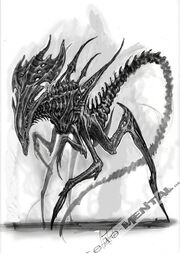
Sekeris' rejected Alien Queen redesign.[21]
Steve Johnson's special effects company Edge FX originally bid for the creature effects in the film, proposing a raft of radical redesigns for both the Aliens and the Predators. To this end, conceptual artist Constantine Sekeris produced several concept sketches of the designs for the various creatures in the film.[21] However, these ideas were eventually rejected for being too different to what had come before, and instead Amalgamated Dynamics, Inc. (ADI) was hired for the movie, having previously worked on Alien3 and Alien Resurrection; although ADI founders Alec Gillis and Tom Woodruff, Jr. had been with Stan Winston's effects company during the production of the original Predator in 1987, they had been employed on another movie (The Monster Squad) at the time, and thus Alien vs. Predator was the first time the duo had a chance to design and build Predators. Visual special effects producers Arthur Windus and John Bruno were in charge of the effects production, including some 400 effects shots in the film.[20] Gillis and Woodruff, along with members of their company, began designing costumes, miniatures and effects in June 2003.
For five months the creatures were redesigned, the Predators wrist blades being extended roughly four times longer than those in the Predator films, and a larger mechanical Plasmacaster was created for the Scar Predator.[7] Owing to the film's comic book origins, it was decided that the Predators should reflect a comic-style silhouette, possessing more heroic proportions: wider shoulders, narrower waists and smaller heads.[22] Technical details were expanded upon from previous entries, while each Predator was given a unique mask to distinguish them from each other. These masks were created using clay, which was used to form molds to create fiberglass copies. These copies were painted to give a weathered look, which Woodruff claims "is what the Predator is all about".[7]
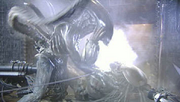
A hydraulic Alien was used to film six scenes as it was faster than a man in a suit. The puppet required six people to operate it.
A hydraulic Alien puppet was created so ADI would be able to make movements faster and give the Alien a "slimline and skeletal" appearance, rather than using an actor in a suit. The puppet required six people to run it; three for the head and body, two for the arms, and a sixth to make sure the signals were reaching the computer. Movements were recorded in the computer so that puppeteers would be able to repeat moves that Anderson liked. The puppet was used in six shots, including the fight scene with the Predator which took one month to film.[7]
The crew tried to keep CGI use to a minimum, as Anderson said people in suits and puppets are scarier than CGI monsters as they are "there in the frame".[7] Roughly 70% of scenes were created using suits, puppets, and miniatures. The Alien queen was filmed using three variations: a 4.8-meter practical version, a 1.2-meter puppet, and a computer-generated version. The practical version required 12 puppeteers to operate.[6] CGI tails were added to the Aliens and the Queen as they were difficult to animate using puppetry.[15][23] Anderson praised Alien director Ridley Scott's and Predator director John McTiernan's abilities at building suspense by not showing the creatures until late in the film, something Anderson wanted to accomplish with Alien vs. Predator. He later commented, "Yes, we make you wait 45 minutes, but once it goes off, from there until the end of the movie, it's fucking relentless".[24]
Music[]
Deleted Scenes[]
Release and Reception[]
Box office[]
Alien vs. Predator was released in North America on August 13, 2004 in 3,395 theaters. The film grossed $38.2 million over its opening weekend for an average of $11,278 per theater, and was number one at the box office. The film spent 16 weeks in cinemas and made $80 million in North America.[25] It grossed $9 million in the United Kingdom, $16 million in Japan, and $8 million in Germany, for an international total of $90.9 million. This brought the film's total gross to $171 million, making it the highest grossing film in the Predator and Alien franchises (excluding the effect of inflation), although Aliens earned more in the domestic box office. Alien vs. Predator was the 33rd highest grossing film of 2004.[26]
Reviews[]
Critics were not allowed to view the film in advance, and once they did the response was generally negative.[27] Based on 132 reviews, the film scored a 21% approval rating on Rotten Tomatoes, and 29 out of 100 based on 21 reviews on Metacritic.[28][29] Chief criticisms of the film included its dialogue, "cardboard characters", PG-13 rating, the "fast-paced editing" during fight sequences, and lighting. However, special effects and set designs received praise.[28][29]
Rick Kisonak of Film Threat praised the film stating, "For a big dumb production about a movie monster smackdown, Alien vs. Predator is a surprisingly good time".[30] Ian Grey of the Orlando Weekly felt, "Anderson clearly relished making this wonderful, utterly silly film; his heart shows in every drip of slime."[30] Staci Layne Wilson of Horror.com called it "a pretty movie to look at with its grandiose sets and top notch creature FX, but it's a lot like Anderson's previous works in that it's all facade and no foundation."[29]
However, with the majority of critics awarding the film a negative review, Michael Wilmington of the Chicago Tribune commented it was full of "monster movie clichés that leave you praying for most of the cast to get killed off fast, to put them (and us) out of our misery."[28] Jack Mathews of New York Daily News panned the movie, stating that "Writer-director Paul W. S. Anderson has created the darkest, if not worst, sci-fi movie since Battlefield Earth."[29] Gary Dowell of Dallas Morning News called the film, "a transparent attempt to jumpstart two run-down franchises".[30] Ed Halter of The Village Voice described the film's lighting for fight sequences as, "black-on-black-in-blackness",[31] while Ty Burr of The Boston Globe felt the lighting "left the audience in the dark".[32] The film received a Golden Raspberry (Razzie) nomination 2005 in the category of "Worst Remake or Sequel".[33]
Fan reception[]
The film was poorly received by fans of the Predator, who felt the film did a disservice to the race of creatures as they had been portrayed in previous movies and, more specifically, the comic books. Many fans believed the Predators were made to look weak and unintelligent, given that two of their number were almost immediately killed off by a single Alien. Many cited the Predators' so-called "movie monster" behavior, whereby the creatures would simply tilt their heads and growl in confusion rather than react to a situation. This is perhaps most evident when Celtic decisively defeats Grid in combat, but instead of making the kill, Celtic spends several seconds admiring his dagger and savouring the moment, during which time Grid revives and duly kills him. Further criticism was directed at the redesign the Predators received. Whereas the Jungle Hunter and City Hunter were both lean, lithe and athletic, the Predators in Alien vs. Predator appeared to be clumsy, bulky and top-heavy with limited mobility.
Alien fans were similarly critical of the film's lack of conformity with regards to the Alien lifecycle, as shown in the other films in the franchise. The time between a victim being subdued by a Facehugger and the Chestburster emerging is supposed to take around 24 hours, yet in the film this process occurs in as little as 10-20 minutes. Likewise, the time it takes for the newly born Chestburster to reach adulthood is also significantly accelerated in the film.
Fans of both franchises were also displeased with the film being set on Earth, in Antarctica, and in the "present". The cold Antarctic setting was seen as contrary to the Predator's stated preference for hot, humid locations, while Alien fans were frustrated by the concept of the Xenomorphs being present on Earth some 118 years before they were supposedly first encountered by humans on LV-426. The manner in which Scar allied himself so readily with Lex was also criticised. Lastly, fans believed that having three Predators and a dozen Aliens facing off in the same location had the makings of an action-packed war zone, yet many were left disappointed by the comparative lack of Alien versus Predator fight sequences in the film.
Home video releases[]
Alien vs. Predator was released on DVD in North America on January 25, 2005.[34] The DVD contained two audio commentaries. The first featured Paul W. S. Anderson, Lance Henriksen, and Sanaa Lathan, while the second included ADI founders Alec Gillis and Tom Woodruff, Jr., and special effects supervisor John Bruno. A 25-minute Making of Featurette and Dark Horse AVP comic covers galley were featured in the special features with three deleted scenes. On release, Alien vs. Predator debuted at number 1 on the Top DVD Sales and Top Video Rental charts in North America.[35][36]
A two-disc Extreme Edition was released on March 7, 2005, featuring the previous release's special features plus a second disc containing behind the scenes featurettes on the conception, pre-production, production, post-production and licensing of the film. An extended Unrated Edition was released on November 22, 2005, including an extended version of the film plus all of the features of the Extreme Edition. Copies of the Unrated Edition sold at Best Buy outlets additionally included the exclusive promotional comic titled Alien vs. Predator: Whoever Wins...We Lose. The film was released on Blu-ray Disc in North America on January 23, 2007.
Unrated Edition[]
Merchandising[]
Author Marc Cerasini wrote a novelization of the movie, notably including a higher level of violence than was included in the film. Although no direct comic book adaptation was produced, Dark Horse Comics did publish an original tie-in comic that incorporated elements from the film's back story into its plot, titled Alien vs. Predator: Thrill of the Hunt. A second comic, Alien vs. Predator: Whoever Wins...We Lose (in fact a reprint of several existing Dark Horse short stories), was packaged exclusively with the Unrated Edition's home video release. Harald Kloser's score was released as a soundtrack album.
Design Studio Press published a behind-the-scenes book looking at the creature effects of the film, titled AVP: Alien vs. Predator: The Creature Effects of ADI. Inkworks also produced a set of trading cards for the film, including a limited edition subset that incorporated samples of fabric from costumes actually worn by the actors in the movie.
Two video games based on the film were developed for mobile phones, the first published by Superscape, and the second by Wicked Witch Software.
Trivia[]
- Director Paul W. S. Anderson had previously been approached to direct Alien Resurrection.[37]
- To date, Alien vs. Predator is the only film in the Alien, Predator and Alien vs. Predator franchises to be rated PG-13 in the United States; all other entries have been rated R. It was also the first entry to be rated 15 in the UK, as opposed to the 18 certificate all previous films had received, although subsequently Aliens vs. Predator: Requiem, Predators, Prometheus and Alien: Covenant have also been rated 15.
- This is the only movie featuring the Xenomorph in which no humans are killed by an adult Alien.
- Much like in Alien, the exploration team wears color-coded uniforms — Stafford's mercenaries wear silver coats, the scientists and archaeologists wear yellow coats, and Quinn's drilling team wear orange overalls. The only exceptions are Weyland and Lex, who also wear silver coats (although Lex quickly removes hers to reveal a red winter jacket and pants beneath).
Goofs[]
See Also[]
- Alien vs. Predator (novel) — The novelization of the film by Marc Cerasini.
- Alien vs. Predator (soundtrack) — The soundtrack to the film by Harald Kloser.
- Alien vs. Predator (2004 Superscape game) — The first of two video games based on the film.
- Alien vs. Predator (2004 Wicked Witch game) — The second video game based on the film.
- HBO First Look: Alien vs. Predator - Behind the Scenes — A documentary about the making of the film, shot during production.
References[]
- ↑ "Box Office Mojo: Alien vs. Predator". Box Office Mojo. Retrieved on 2008-04-21.
- ↑ 2.0 2.1 Cinescape Presents v3 #9, Movie Aliens
- ↑ Dave Hughes, Lee Brimmicombe-Wood. Aliens, Vol. 2 #4, p. 14 (1992), Dark Horse International.
- ↑ Davidson, Paul (2002-03-07). "Alien vs. Predator Still Seeking a Script". IGN. Retrieved on 2008-01-13.
- ↑ Davidson, Paul (2002-07-15). "Anderson Will Direct Aliens vs. Predator". IGN. Retrieved on 2008-01-13.
- ↑ 6.0 6.1 6.2 6.3 Audio commentary by Paul W. S. Anderson, Lance Henriksen and Sanaa Lathan, 2004, 20th Century Fox
- ↑ 7.0 7.1 7.2 7.3 7.4 7.5 Paul W. S. Anderson, John Davis, Lance Henriksen, David Johnson, Tom Woodruff, Jr.. The Making of AVP (2005), 20th Century Fox [DVD].
- ↑ Seeton, Reg and Van Buskirk, Dayna. "Armageddon It: Shane Salerno Speaks Out! - Part Two". Screenwriting.ugo. Retrieved on 2008-01-13.
- ↑ 9.0 9.1 9.2 "Aliens vs. Predator featurette". Apple.com. Retrieved on 2008-01-13.
- ↑ "The Hollywood Reporter - Ridley Scott, Michael Fassbender, Noomi Rapace Tease 'Prometheus' at CineEurope". Retrieved on 2012-06-14.
- ↑ Twentieth Century Fox Film Corporation, Alien: Definitive Edition DVD
- ↑ 12.0 12.1 Let's get ready to rumble!, Movie Magic, January 2005, page 62
- ↑ Fangoria #239, p 37-38
- ↑ Horn, Steven. "Interview with AvP Director Paul Anderson". IGN. Retrieved on 2008-01-15.
- ↑ 15.0 15.1 15.2 "Alien vs. Predator production notes". AVP-movie. Retrieved on 2008-01-14.
- ↑ Utichi, Joe (2004-10-04). "Exclusive: Paul Anderson on AvP". filmfocus.co.uk. Retrieved on 2008-01-16.
- ↑ Rose, Tiffany (2004-08-20). "Sigourney Weaver: Loving the alien". arts.independent.co.uk. Retrieved on 2008-01-16.
- ↑ Jean-Pierre Jeunet, Sylvain Despretz, Darius Khondji, Pitof, Alec Gillis, Tom Woodruff, Jr.. One Step Beyond: Making Alien Resurrection (2003), 20th Century Fox [DVD].
- ↑ "Alien vs. Predator A New World Vision". Spike.com. Retrieved on 2008-01-14.
- ↑ 20.0 20.1 20.2 Campbell, Josh (2004-02-05). "Local shoots shrinking". The Prague Post. Retrieved on 2008-01-13.
- ↑ 21.0 21.1 "RAR Writes - AVP: ALIENS VS. PREDATOR Concept Art by Constantine Sekeris". Retrieved on 2015-05-22.
- ↑ Alec Gillis, Tom Woodruff, Jr.. AVP: Alien vs. Predator: The Creature Effects of ADI, p. 23 (2004), Design Studio Press.
- ↑ Audio commentary by Alec Gillis, Tom Woodruff and John Bruno, 2004, 20th Century Fox
- ↑ Salisbury, Mark. The AVP referee, Fangoria issue #235, page 44
- ↑ "Alien vs. Predator gross". Box Office Mojo. Retrieved on 2008-01-13.
- ↑ "2004 Domestic gross (2004)". Box Office Mojo. Retrieved on 2008-01-20.
- ↑ Kehr, Dave (2004-08-14). "It's an Underground Monster World Series". New York Times. Retrieved on 2008-01-24.
- ↑ 28.0 28.1 28.2 "Alien vs. Predator critic reviews". Rotten Tomatoes. Retrieved on 2008-01-13.
- ↑ 29.0 29.1 29.2 29.3 "Alien vs. Predator Metacritic". Metacritic.com. Retrieved on 2008-01-13.
- ↑ 30.0 30.1 30.2 "Alien vs. Predator reviews Page 2". Rotten Tomatoes.com. Retrieved on 2008-01-20.
- ↑ Halter, Ed (2004-08-13). "Slime Pickings". The Village Voice. Retrieved on 2008-01-29.
- ↑ Burr, Ty (2004-08-14). "Alien vs. Predator is an enjoyable schlockfest". The Boston Globe. Retrieved on 2008-01-29.
- ↑ "25th annual Razzie awards - Worst remake or sequel". Razzies.com. Retrieved on 2008-01-13.
- ↑ "Alien Vs. Predator (Widescreen Edition)". Amazon.com. Retrieved on 2008-01-29.
- ↑ "Top DVD sales for the week of Feb 19, 2005". Billboard.com. Archived from the original on 2008-02-04. Retrieved on 2008-01-20.
- ↑ "Top Video rentals for the week of Feb 19, 2005". Billboard.com. Archived from the original on 2008-02-03. Retrieved on 2008-01-20.
- ↑ "Tor.com - I'm the Monster's Mother: Alien Resurrection". Retrieved on 2014-10-23.
[]
| |||||||||||
